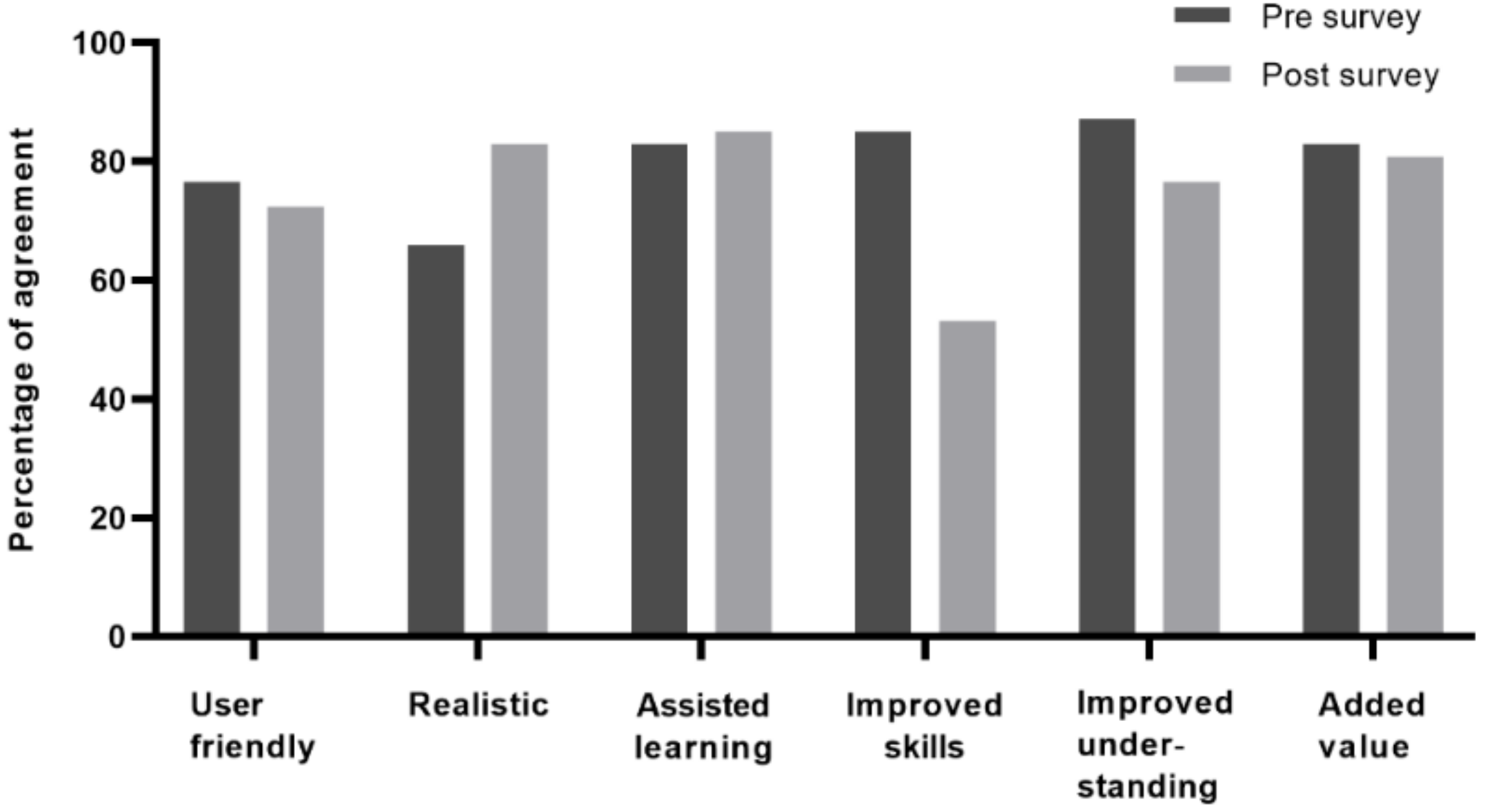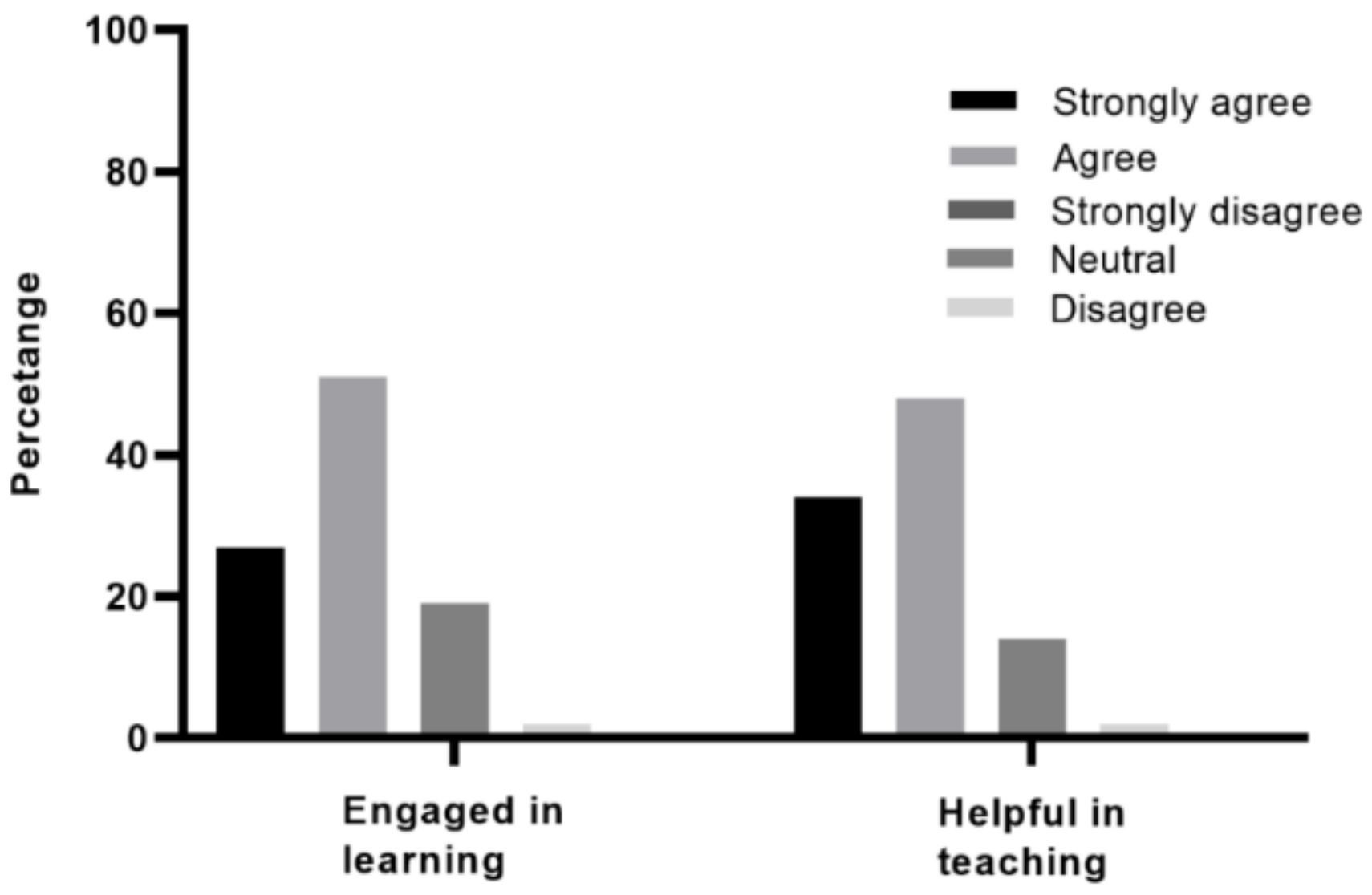Assessing the Pedological Impact of Local Anesthesia Dental Simulator as Serious Game
Abstract
:1. Introduction
2. Materials and Methods
2.1. Application of a Serious Game for LA
2.2. Ethical Approval and Participant Recruitment
2.3. Survey Instrument and Piloting
2.4. Statistical Analysis
3. Results
3.1. Participants’ Demographics
3.2. Pre-Training Survey
3.3. Post-Training Survey
3.4. Open-Ended Responses
4. Discussion
5. Conclusions
Author Contributions
Funding
Institutional Review Board Statement
Informed Consent Statement
Data Availability Statement
Conflicts of Interest
References
- Zafar, S.; Lai, Y.; Sexton, C.; Siddiqi, A. Virtual Reality as a novel educational tool in pre-clinical paediatric dentistry training: Students’ perceptions. Int. J. Paediatr. Dent. 2020, 30, 791–797. [Google Scholar] [CrossRef] [PubMed]
- Zafar, S.; Zachar, J. Evaluation of augmented reality application for learning dental anatomy as a novel educational tool. Eur. J. Dent. Educ. 2020, 24, 259–265. [Google Scholar] [CrossRef] [PubMed]
- Marei, H.F.; Al-Jandan, B.A. Simulation-based local anaesthesia teaching enhances learning outcomes. Eur. J. Dent. Educ. 2013, 17, e44–e48. [Google Scholar] [CrossRef] [PubMed]
- Miller, J.L.; Rambeck, J.H.; Snyder, A. Improving Emergency Preparedness System Readiness through Simulation and Interprofessional Education. Public Health Rep. 2014, 129, 129–135. [Google Scholar] [CrossRef] [PubMed] [Green Version]
- Jabbar, A.I.; Felicia, P. Gameplay engagement and learning in game-based learning: A systematic review. Rev. Educ. Res. 2015, 85, 740–779. [Google Scholar] [CrossRef]
- Zafar, S.; Siddiqi, A.; Yasir, M.; Zachar, J. Pedagogical development in local anaesthetic training in paediatric dentistry using virtual reality simulator. Eur. Arch. Paediatr. Dent. 2021, 22, 667–674. [Google Scholar] [CrossRef] [PubMed]
- Kenny, K.; Alkazme, A.; Day, P. The effect of viewing video clips of paediatric local anaesthetic administration on the confidence of undergraduate dental students. Eur. J. Dent. Educ. 2018, 22, 57–62. [Google Scholar] [CrossRef] [PubMed]
- Knipfer, C.; Rohde, M.; Oetter, N.; Muench, T.; Kesting, M.R.; Stelzle, F. Local anaesthesia training for undergraduate students—How big is the step from model to man? BMC Med. Educ. 2018, 18, 308. [Google Scholar] [CrossRef] [PubMed]
- Mladenovic, R.; Pereira, L.; Mladenovic, K.; Videnovic, N.; Bukumiric, Z.; Mladenovic, J. Effectiveness of augmented reality mobile simulator in teaching local anesthesia of inferior alveolar nerve block. J. Dent. Educ. 2019, 83, 423–428. [Google Scholar] [CrossRef] [PubMed] [Green Version]
- Monterubbianesi, R.; Tosco, V.; Vitiello, F.; Orilisi, G.; Fraccastoro, F.; Putignano, A.; Orsini, G. Augmented, Virtual and Mixed Reality in Dentistry: A Narrative Review on the Existing Platforms and Future Challenges. Appl. Sci. 2022, 12, 877. [Google Scholar] [CrossRef]
- Mladenovic, R.; Bukumiric, Z.; Mladenovic, K. Practice of local anesthesia applications in 3D environment during the COVID-19 pandemic. J. Dent. Educ. 2021, 85 (Suppl. S1), 1170–1172. [Google Scholar] [CrossRef] [PubMed]
- Mladenovic, R.; Mladenovic, K.; Milanovic, P.; Selakovic, D. Augmented reality technology as a method of distance learning for local anesthesia training. J. Dent. Educ. 2021, 85 (Suppl. S3), 2038–2040. [Google Scholar] [CrossRef] [PubMed]
- Mladenovic, R.; Dakovic, D.; Pereira, L.; Matvijenko, V.; Mladenovic, K. Effect of augmented reality simulation on administration of local anaesthesia in paediatric patients. Eur. J. Dent. Educ. 2020, 24, 507–512. [Google Scholar] [CrossRef] [PubMed]
- Sipiyaruk, K.; Gallagher, J.E.; Hatzipanagos, S.; Reynolds, P.A. A rapid review of serious games: From healthcare education to dental education. Eur. J. Dent. Educ. 2018, 22, 243–257. [Google Scholar] [CrossRef] [PubMed]
- Gentry, S.V.; Gauthier, A.; Ehrstrom, B.L.E.; Wortley, D.; Lilienthal, A.; Car, L.T.; Dauwels-Okutsu, S.; Nikolaou, C.K.; Zary, N.; Campbell, J.; et al. Serious gaming and gamification education in health professions: Systematic review. J. Med. Internet Res. 2019, 21, e12994. [Google Scholar] [CrossRef] [PubMed] [Green Version]
- Ram, D.; Peretz, B. Administering local anaesthesia to paediatric dental patients—Current status and prospects for the future. Int. J. Paediatr. Dent. 2002, 12, 80–89. [Google Scholar] [CrossRef] [PubMed]
- Hanson, K.M.; Jones, N.; Krantz, M.; Law, H. Techniques for administering local anesthesia utilizing mixed-reality technology. J. Dent. Res. 2006, 85, 169. [Google Scholar]
- Pacheco, P.I.P. The Need For, and the Use of, Three Dimensional Simulation in Dental Education. Ph.D. Thesis, University of Dundee, Dundee, UK, 2017. [Google Scholar]
- Mladenovic, R.; AlQahtani, S.; Mladenovic, K.; Bukumiric, Z.; Zafar, S. Effectiveness of technology-enhanced teaching methods of undergraduate dental skills for local anaesthesia administration during COVID-19 era: Students’ perception. BMC Oral Health 2022, 22, 40. [Google Scholar] [CrossRef] [PubMed]
- Sipiyaruk, K.; Hatzipanagos, S.; Reynolds, P.A.; Gallagher, J.E. Serious Games and the COVID-19 Pandemic in Dental Education: An Integrative Review of the Literature. Computers 2021, 10, 42. [Google Scholar] [CrossRef]



| Statement | Responses (%) | ||
|---|---|---|---|
| Agreement | Neutral | Disagreement | |
| I am excited about using the LA dental simulator for LA training | |||
| 80.85 | 19.15 | 0 |
| 82.36 | 11.76 | 5.88 |
| I expect the LA dental simulator to be user friendly | |||
| 76.6 | 17.02 | 6.38 |
| 82.35 | 17.65 | 0 |
| I expect working on the LA dental simulator is realistic | |||
| 64.96 | 23.4 | 10.64 |
| 74.47 | 17.65 | 5.88 |
| I expect that the LA dental simulator will assist my learning | |||
| 82.98 | 14.89 | 2.13 |
| 76.47 | 17.65 | 5.88 |
| I expect that using the LA dental simulator will improve my LA administration skills | |||
| 85.1 | 10.64 | 4.26 |
| 94.24 | 11.76 | 0 |
| I expect working on the LA dental simulator will allow me to see the 3D anatomical structures that will increase my understanding for LA administration | |||
| 87.24 | 12.77 | 0 |
| 82.36 | 17.65 | 0 |
| I expect added value in the use of the LA dental simulator in my training compared to relying solely on traditional methods of training of LA training | |||
| 82.96 | 17.02 | 0 |
| 82.36 | 17.65 | 0 |
| Statement | Responses (%) | ||
|---|---|---|---|
| Agreement | Neutral | Disagreement | |
| I felt comfortable using the LA dental simulator | |||
| 78.72 | 19.15 | 2.13 |
| 88.23 | 11.76 | 0 |
| Local anesthesia dental simulator is user friendly | |||
| 72.34 | 19.15 | 8.51 |
| 76.47 | 23.53 | 0 |
| 3-D images of the anatomy in the LA dental simulator looked realistic | |||
| 82.98 | 17.02 | 0 |
| 82.36 | 17.65 | 0 |
| Using LA dental simulator assisted my learning | |||
| 85.1 | 12.77 | 2.13 |
| 88.23 | 11.76 | 0 |
| I felt more confident about my LA administration skills after using LA dental simulator | |||
| 59.57 | 34.04 | 6.38 |
| 64.71 | 17.65 | 17.64 |
| 3-D anatomical structures on LA dental simulator improved my understanding of anatomical landmarks | |||
| 76.6 | 21.28 | 2.13 |
| 88.24 | 11.76 | 0 |
| The use of LA dental simulator added value in my training compared to relying solely on traditional methods | |||
| 80.85 | 17.02 | 2.13 |
| 64.71 | 23.53 | 11.76 |
| The use of LA dental simulator improved my skills of LA administration | |||
| 53.19 | 31.91 | 14.89 |
| 64.71 | 17.65 | 17.65 |
| When using LA dental simulator, I felt I was engaged in a learning activity | |||
| 78.72 | 19.15 | 2.13 |
| 87.58 | 11.76 | 0 |
| I think the use of LA dental simulator would be helpful in teaching LA administration technique | |||
| 82.98 | 14.89 | 2.13 |
| 88.24 | 5.88 | 5.88 |
Publisher’s Note: MDPI stays neutral with regard to jurisdictional claims in published maps and institutional affiliations. |
© 2022 by the authors. Licensee MDPI, Basel, Switzerland. This article is an open access article distributed under the terms and conditions of the Creative Commons Attribution (CC BY) license (https://creativecommons.org/licenses/by/4.0/).
Share and Cite
Zafar, S.; Mladenovic, K.; AlQahtani, S.; Puranik, C.; Mladenovic, R. Assessing the Pedological Impact of Local Anesthesia Dental Simulator as Serious Game. Appl. Sci. 2022, 12, 3285. https://doi.org/10.3390/app12073285
Zafar S, Mladenovic K, AlQahtani S, Puranik C, Mladenovic R. Assessing the Pedological Impact of Local Anesthesia Dental Simulator as Serious Game. Applied Sciences. 2022; 12(7):3285. https://doi.org/10.3390/app12073285
Chicago/Turabian StyleZafar, Sobia, Kristina Mladenovic, Sakher AlQahtani, Chaitanya Puranik, and Rasa Mladenovic. 2022. "Assessing the Pedological Impact of Local Anesthesia Dental Simulator as Serious Game" Applied Sciences 12, no. 7: 3285. https://doi.org/10.3390/app12073285
APA StyleZafar, S., Mladenovic, K., AlQahtani, S., Puranik, C., & Mladenovic, R. (2022). Assessing the Pedological Impact of Local Anesthesia Dental Simulator as Serious Game. Applied Sciences, 12(7), 3285. https://doi.org/10.3390/app12073285








